Christ Church Cathedral
A simple cathedral with a few notable tombs and a nice crypt
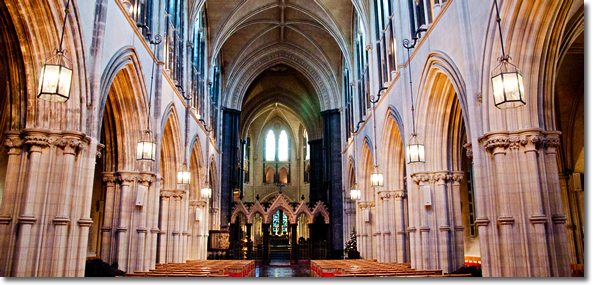
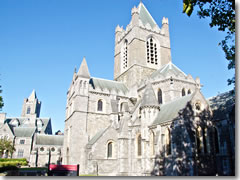 Though the current structure is mainly Gothic—largely rebuilt in the 1870s after serving time as an indoor market—the remaining bits of the 12th-century Norman-style church erected here by Strongbow and his cohorts represent the oldest stone building in Dublin.
Though the current structure is mainly Gothic—largely rebuilt in the 1870s after serving time as an indoor market—the remaining bits of the 12th-century Norman-style church erected here by Strongbow and his cohorts represent the oldest stone building in Dublin.
Strongbow himself, who helped conquer Ireland for the Normans (see "Who was Strongbow?" below), supposedly rests in peace inside, in a worn sarcophagus about a third of the way up the right aisle, between two piers and hemmed in by nave chairs.
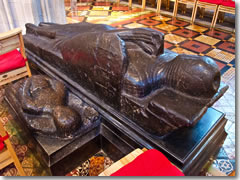
The "tomb of Strongbow" in Christchurch Cathedral, DublinHowever, this “tomb” is actually a replacement for the original monument, which was destroyed when the roof collapsed in 1562.
Also, the grave effigy itself is modeled after the Earl of Drogheda.
Even more also, Strongbow was actually reburied, at some point, in the Cathedral of Ferns in Co. Wexford (where, incidentally, is also buried the erstwhile King of Leinster, Mac Murchada; see "Who was Stongbow?" below).
Some argue that no matter whence came the tomb, Strongbow's entrails at least were kept here in Christ Church and remain here under this stone slab.
(Some say that the curious, small half-figure tomb right next to it is the tomb of Strongbow's son, sliced in half by his father when Strongbow suspected that junior lacked in the bravery department.
In reality, it is highly unlikely De Clere would have murdered his only son and heir, leaving just a daughter to inherit everything; more on her in just a bit. It might, indeed, be the tomb of poor young Gilbert de Clare, 3rd Earl of Pembroke, and is only pint-sized because he died at the age of 12.)
Strongbow was the way-cool nickname of a much reviled figure in Irish history, an Anglo-Norman nobleman whose proper name was Richard de Clare, 2nd Earl of Pembroke.
Miffed at being rebuffed by his cousin, King Henry II, he decided to get into the mercenary game and saw the political advantages in helping the deposed Irish King of Leinster seek to retake his throne in the late 1160s—Ireland was a patchwork of kingdoms at the time, though all paid fealty to the High King at Tara.
This deposed King of Leinster was named Diarmait Mac Murchada (“Dermot MacMurrough”), which is how the Irish spell “Benedict Arnold.”
No, really; poor, reviled Dairmait really only wanted to get his kingdom back, and he got it thanks to the efforts of Strongbow and other Anglo-Norman and Welsh chieftains and their troops.
He gave Strongbow his daughter Aoife in marriage (and even recklessly promised him the kingship after he died).
Seeing how easy conquest was once you had hired swords and bows, Dairmait’s ambitions grew and he set his sights on the High Kingship of Ireland itself. He died, however, in 1171—supposedly from a broken heart after the death of his son—mere months after conquering Dublin and resecuring his throne.
In hiring Strongbow and company, however, Dairmait had made a teensy tiny tactical mistake, one that would haunt Ireland for more than eight centuries.
See, in order to use the services of the subjects of King Henry II in a political war—subjects like Strongbow and his allies—Dairmait had to ask Henry’s permission. And to do that, he had to swear an oath of fealty to Henry.
Upon Dairmait’s death, Henry—Count of Anjou, Duke of Normandy, King of England, and ruler of Brittany, Scotland, and Wales—decided to press his new claims and add Ireland to his impressive list of political possessions.
By 1172, Henry II controlled the entire eastern half of Ireland.
This Norman invasion of Ireland kicked off 750 years of rule by the English crown—or 843 years and counting if you’re talking about the six northerly counties that once made up the Kingdom of Ulster and that we now call “Northern Ireland.”
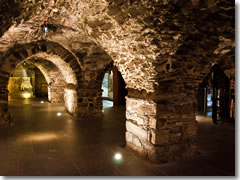
The crypt beneath Christchurch Cathedral, Dublin There is a modest treasury (golden chalices, embroided reliquaries, etc.), and a quite lovely floor of different colored tiles in pretty patterns.
Visit the huge crypt underneath the church which extends the length of the nave and was filled with taverns during the Middle Ages—appropriately enough, as of 2011 the food and drink has returned with the opening of a cafe down here.
Don't miss the glass case with the famous cat and rat, two mummified corpses found in an old organ pipe locked in an macabre eternal chase.
Tips
- Planning your time: A spin around the church takes only about 20–30 minutes, crypt and treasury included.
- Tours of Christ Church Cathedral: There are docent tours (€4) of the cathedral Mondays, Fridays, and Saturdays noon–2pm (thoguh those time are subject to change, so always check first).
- Commerical tours: Take a tour that includes a stop at Christ Church Catehdral with our partners at Viator.com:
- Dublin Pass: You can get into Christ Church Cathedral for free using the Dublin Pass. The pass also gets you a €1 discount on the audio tour.


- Joint ticket: TK
- Choral services at Christ Church Cathedral: Listen to the choir perform Evensong Wednesdays and Thursdays at 6pm, Sundays at 3:30pm (plus a sung Sunday 11am Eucharist).
- Attending mass at Christ Church Cathedral: Services are held daily: Mon–Fri, 10am Morning Prayer and 12:45pm Eucharist; Mon–Sat noon Prayer for Peace and 5pm Evening Prayer (when no choral service). On the 4th Sunday of the month, there's a 5pm Eucharist held in the Irish language.
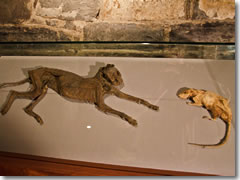
The cat and the rat in The crypt beneath Christchurch Cathedral, Dublin
Related Articles |
Related Partners
|
This article was by Reid Bramblett and last updated in February 2012.
All information was accurate at the time.
Copyright © 1998–2013 by Reid Bramblett. Author: Reid Bramblett.
Christ Church Place (off Lord Ebury St.).
Tel. +353-(0)1/677-8099
www.christchurchdublin.ie
OPEN
Apr-May, Sept-Oct: Mon–Sat 9:30am–6pm
Sun 12:30–2:30pm
June-Aug: Mon–Sat 9:30am–7pm
Sun 12:30–2:30pm and 4:30–6pm
Nov-Mar: Mon–Sat 9:30am–5pm
ADMISSION
€6
[Joint ticket with Dublinia: €TK]
Dublin Pass: Yes (free)
TRANSPORT
Bus: 49, 49A, 49X, 50X, 51B, 51C, 54A, 78A, 121, 123, 150
LUAS: The Four Courts
